Land Cover Mapping and Ecological Risk Assessment in the Context of Recent Ecological Migration
Abstract
:1. Introduction
2. Study Area and Dataset
2.1. Study Area
2.2. Dataset
3. Methods
3.1. Reference Dataset for Training and Validation Samples
3.2. The Classification of Basic Year Images
3.3. Detection of Potential Area Changes
3.4. Land Cover Mapping of Comparison Years
3.5. Accuracy Assessment
3.6. Ecological Risk Assessment
4. Results
4.1. Multi-Temporal Classification Maps and Accuracy Assessment
4.1.1. Classification Results and Accuracy Assessment of the Basic Year
4.1.2. Classification Results and Accuracy Assessment of Comparison Years
4.2. Area Change Detection and Accuracy Assessment
4.3. Land Cover Change Patterns
4.4. Spatial and Temporal Differentiation of Landscape Ecological Risk
5. Discussion
5.1. Advantages and Limitations of Multi-Temporal Land Cover Mapping in GEE
5.2. Analysis of the Method of Land Cover Mapping
5.3. Influence of EM
5.3.1. Influence of EM on Land Cover Change
5.3.2. Influence of EM on ER
5.3.3. Influence of EM on Other Aspects
5.4. Limitations and Future Works
6. Conclusions
Supplementary Materials
Author Contributions
Funding
Data Availability Statement
Acknowledgments
Conflicts of Interest
References
- Transforming our World: The 2030 Agenda for Sustainable Development; UN: Geneva, Switzerland, 2015.
- Ge, Y.; Yuan, Y.; Hu, S.; Ren, Z.; Wu, Y. Space–time variability analysis of poverty alleviation performance in China’s poverty-stricken areas. Spat. Stat. 2017, 21, 460–474. [Google Scholar] [CrossRef]
- New Progress in Development-Oriented Poverty Reduction Program for Rural China; Information Office of the State Council: Beijing, China, 2011.
- Wang, W.; Ren, Q.; Yu, J. Impact of the ecological resettlement program on participating decision and poverty reduction in southern Shaanxi, China. For. Policy Econ. 2018, 95, 1–9. [Google Scholar] [CrossRef]
- Trier, T.; Turashvili, M. Resettlement of Ecologically Displaced Persons Solution of a Problem or Creation of a New? Eco-Migration in Georgia 1981–2006; European Centre for Minority Issues: Flensburg, Germany, 2007. [Google Scholar]
- Ezra, M. Ecological Degradation, Rural Poverty, and Migration in Ethiopia: A Contextual Analysis; Population Council: New York, NY, USA, 2001. [Google Scholar]
- Leete, R. Population Environment and poverty. In Population and Development Strategies; United Nation Population Fund: New York, NY, USA, 2001; Volume 1. [Google Scholar]
- Sun, C.; Liu, J.; Zhang, X.; Du, H.; Ma, W. Regional Effects of Secondary Ecological Migration in Pasturing Area: A Case of Fuhai County in Xinjiang. In Proceedings of the 2009 International Conference on Environmental Science and Information Application Technology, Wuhan, China, 4–5 July 2009; pp. 263–268. [Google Scholar]
- Liu, Y.; Liu, J.; Zhou, Y. Spatio-temporal patterns of rural poverty in China and targeted poverty alleviation strategies. J. Rural Stud. 2017, 52, 66–75. [Google Scholar] [CrossRef]
- MFA; UN. Report on China’s Implementation of the Millennium Development Goals (2000–2015); Ministry of Foreign Affairs People’s Republic of China: Beijing, China, 2015.
- Nawrotzki, R.J.; Riosmena, F.; Hunter, L.M.; Runfola, D.M. Amplification or suppression: Social networks and the climate change—migration association in rural Mexico. Glob. Environ. Chang. 2015, 35, 463–474. [Google Scholar] [CrossRef] [Green Version]
- Bedford, R.; Bedford, C. International migration and climate change: A post-Copenhagen perspective on options for Kiribati and Tuvalu. Clim. Chang. Migr. South Pac. Perspect. 2010, 89–134. [Google Scholar] [CrossRef]
- Estel, S.; Kuemmerle, T.; Alcántara, C.; Levers, C.; Prishchepov, A.; Hostert, P. Mapping farmland abandonment and recultivation across Europe using MODIS NDVI time series. Remote Sens. Environ. 2015, 163, 312–325. [Google Scholar] [CrossRef]
- Dara, A.; Baumann, M.; Kuemmerle, T.; Pflugmacher, D.; Rabe, A.; Griffiths, P.; Hölzel, N.; Kamp, J.; Freitag, M.; Hostert, P. Mapping the timing of cropland abandonment and recultivation in northern Kazakhstan using annual Landsat time series. Remote Sens. Environ. 2018, 213, 49–60. [Google Scholar] [CrossRef]
- Yin, H.; Pflugmacher, D.; Li, A.; Li, Z.; Hostert, P. Land use and land cover change in Inner Mongolia—Understanding the effects of China’s re-vegetation programs. Remote Sens. Environ. 2018, 204, 918–930. [Google Scholar] [CrossRef]
- Zhao, H.; Wu, R.; Hu, J.; Yang, F.; Wang, J.; Guo, Y.; Zhou, J.; Wang, Y.; Zhang, C.; Feng, Z. The contrasting east–west pattern of vegetation restoration under the large-scale ecological restoration programmes in southwest China. Land Degrad. Dev. 2020, 31, 1688–1698. [Google Scholar] [CrossRef]
- Ou, C.; Yang, J.; Du, Z.; Liu, Y.; Feng, Q.; Zhu, D. Long-Term Mapping of a Greenhouse in a Typical Protected Agricultural Region Using Landsat Imagery and the Google Earth Engine. Remote Sens. 2019, 12, 55. [Google Scholar] [CrossRef] [Green Version]
- Mo, W.; Wang, Y.; Zhang, Y.; Zhuang, D. Impacts of road network expansion on landscape ecological risk in a megacity, China: A case study of Beijing. Sci. Total Environ. 2017, 574, 1000–1011. [Google Scholar] [CrossRef] [PubMed] [Green Version]
- Zhu, Z.; Woodcock, C.E. Continuous change detection and classification of land cover using all available Landsat data. Remote Sens. Environ. 2014, 144, 152–171. [Google Scholar] [CrossRef] [Green Version]
- Bovolo, F.; Marchesi, S.; Bruzzone, L. A Framework for Automatic and Unsupervised Detection of Multiple Changes in Multitemporal Images. IEEE Trans. Geosci. Remote Sens. 2012, 50, 2196–2212. [Google Scholar] [CrossRef]
- Yao, X.; Li, G.; Xia, J.; Ben, J.; Cao, Q.; Zhao, L.; Ma, Y.; Zhang, L.; Zhu, D. Enabling the Big Earth Observation Data via Cloud Computing and DGGS: Opportunities and Challenges. Remote Sens. 2019, 12, 62. [Google Scholar] [CrossRef] [Green Version]
- Xie, Z.; Phinn, S.R.; Game, E.T.; Pannell, D.J.; Hobbs, R.J.; Briggs, P.R.; McDonald-Madden, E. Using Landsat observations (1988–2017) and Google Earth Engine to detect vegetation cover changes in rangelands—A first step towards identifying degraded lands for conservation. Remote Sens. Environ. 2019, 232. [Google Scholar] [CrossRef]
- Tamiminia, H.; Salehi, B.; Mahdianpari, M.; Quackenbush, L.; Adeli, S.; Brisco, B. Google Earth Engine for geo-big data applications: A meta-analysis and systematic review. ISPRS J. Photogramm. Remote Sens. 2020, 164, 152–170. [Google Scholar] [CrossRef]
- Shelestov, A.; Lavreniuk, M.; Kussul, N.; Novikov, A.; Skakun, S. Exploring Google Earth Engine Platform for Big Data Processing: Classification of Multi-Temporal Satellite Imagery for Crop Mapping. Front. Earth Sci. 2017, 5. [Google Scholar] [CrossRef] [Green Version]
- Xie, S.; Liu, L.; Zhang, X.; Yang, J.; Chen, X.; Gao, Y. Automatic Land-Cover Mapping using Landsat Time-Series Data based on Google Earth Engine. Remote Sens. 2019, 11, 3023. [Google Scholar] [CrossRef] [Green Version]
- Phan, T.N.; Kuch, V.; Lehnert, L.W. Land Cover Classification using Google Earth Engine and Random Forest Classifier—The Role of Image Composition. Remote Sens. 2020, 12, 2411. [Google Scholar] [CrossRef]
- Piet, G.J.; Knights, A.M.; Jongbloed, R.H.; Tamis, J.E.; de Vries, P.; Robinson, L.A. Ecological risk assessments to guide decision-making: Methodology matters. Environ. Sci. Policy 2017, 68, 1–9. [Google Scholar] [CrossRef] [Green Version]
- Peng, J.; Zong, M.; Hu, Y.n.; Liu, Y.; Wu, J. Assessing Landscape Ecological Risk in a Mining City: A Case Study in Liaoyuan City, China. Sustainability 2015, 7, 8312–8334. [Google Scholar] [CrossRef] [Green Version]
- Luo, F.; Liu, Y.; Peng, J.; Wu, J. Assessing urban landscape ecological risk through an adaptive cycle framework. Landsc. Urban Plan. 2018, 180, 125–134. [Google Scholar] [CrossRef]
- USEPA. Guidelines for ecological risk assessment. J. Object Technol. 1998, 23, 501–507. [Google Scholar]
- Liu, D.; Chen, H.; Zhang, H.; Geng, T.; Shi, Q. Spatiotemporal Evolution of Landscape Ecological Risk Based on Geomorphological Regionalization during 1980–2017: A Case Study of Shaanxi Province, China. Sustainability 2020, 12, 941. [Google Scholar] [CrossRef] [Green Version]
- Wang, H.; Liu, C.; Zang, F.; Yang, J.; Li, N.; Rong, Z.; Zhao, C. Impacts of Topography on the Land Cover Classification in the Qilian Mountains, Northwest China. Can. J. Remote Sens. 2020, 46, 344–359. [Google Scholar] [CrossRef]
- Reuveny, R. Ecomigration and Violent Conflict: Case Studies and Public Policy Implications. Hum. Ecol. 2007, 36, 1–13. [Google Scholar] [CrossRef]
- Yaofeng, J.I.A. Review of benefit evaluation research on ecological migration in China. Resour. Sci. 2016, 38, 87–92. [Google Scholar] [CrossRef]
- Wei, W.; Zhou, T.; Guo, Y.-c.; Li, Z.-y.; Zhang, X.-y. Spatiotemporal evolution of land ecological sensitivity in arid inland river basin based on remote sensing index: A case of Wuwei City in Shiyang River Basin. Chin. J. Ecol. 2020, 39, 3068. [Google Scholar]
- Huang, H.; Chen, Y.; Clinton, N.; Wang, J.; Wang, X.; Liu, C.; Gong, P.; Yang, J.; Bai, Y.; Zheng, Y.; et al. Mapping major land cover dynamics in Beijing using all Landsat images in Google Earth Engine. Remote Sens. Environ. 2017, 202, 166–176. [Google Scholar] [CrossRef]
- Foga, S.; Scaramuzza, P.L.; Guo, S.; Zhu, Z.; Dilley, R.D.; Beckmann, T.; Schmidt, G.L.; Dwyer, J.L.; Joseph Hughes, M.; Laue, B. Cloud detection algorithm comparison and validation for operational Landsat data products. Remote Sens. Environ. 2017, 194, 379–390. [Google Scholar] [CrossRef] [Green Version]
- Farr, T.G.; Rosen, P.A.; Caro, E.; Crippen, R.; Duren, R.; Hensley, S.; Kobrick, M.; Paller, M.; Rodriguez, E.; Roth, L.; et al. The Shuttle Radar Topography Mission. Rev. Geophys. 2007, 45. [Google Scholar] [CrossRef] [Green Version]
- Cutler, A.C.; Cutler, D.R.; Stevens, J.R. Random Forests. Mach. Learn. 2004, 45, 157–176. [Google Scholar]
- Cracknell, M.J.; Reading, A.M. Geological mapping using remote sensing data: A comparison of five machine learning algorithms, their response to variations in the spatial distribution of training data and the use of explicit spatial information. Comput. Geosci. 2014, 63, 22–33. [Google Scholar] [CrossRef] [Green Version]
- Elmore, A.J.; Mustard, J.F.; Manning, S.J.; Lobell, D.B. Quantifying vegetation change in semiarid environments Precision and accuracy of spectral mixture analysis and the normalized difference vegetation index. Remote Sens. Environ. 2000, 73, 87–102. [Google Scholar] [CrossRef]
- Matsushita, B.; Yang, W.; Chen, J.; Onda, Y.; Qiu, G. Sensitivity of the enhanced vegetation index (EVI) and normalized difference vegetation index (NDVI) to topographic effects a case study in high-density cypress forest. Sensors 2007, 7, 2636–2651. [Google Scholar] [CrossRef] [PubMed] [Green Version]
- Gitelson, A.A.; Kaufman, Y.J.; Merzlyak, M.N. Use of a green channel in remote sensing of global vegetation from EOS-MODIS. Remote Sens. Environ. 1996, 58, 289–298. [Google Scholar] [CrossRef]
- Huete, A.R. A soil adjusted vegetation index (SAVI). Remote Sens. Environ. 1988, 25, 295–309. [Google Scholar] [CrossRef]
- Zha, Y.; Gao, J.; Ni, S. Use of normalized difference built-up index in automatically mapping urban areas from TM imagery. Int. J. Remote Sens. 2010, 24, 583–594. [Google Scholar] [CrossRef]
- Xu, H. Modification of normalised difference water index (NDWI) to enhance open water features in remotely sensed imagery. Int. J. Remote Sens. 2007, 27, 3025–3033. [Google Scholar] [CrossRef]
- Haralick, R.M.; Shanmugan, K.; Dinstein, I.H. Textural features for image classification. IEEE Trans. Syst. ManCybern. 1973, 6, 610–621. [Google Scholar] [CrossRef] [Green Version]
- Xu, Y.; Yu, L.; Zhao, F.R.; Cai, X.; Zhao, J.; Lu, H.; Gong, P. Tracking annual cropland changes from 1984 to 2016 using time-series Landsat images with a change-detection and post-classification approach: Experiments from three sites in Africa. Remote Sens. Environ. 2018, 218, 13–31. [Google Scholar] [CrossRef]
- Morton, D.C.; Nagol, J.; Carabajal, C.C.; Rosette, J.; Palace, M.; Cook, B.D.; Vermote, E.F.; Harding, D.J.; North, P.R.J. Amazon forests maintain consistent canopy structure and greenness during the dry season. Nature 2014, 506, 221–224. [Google Scholar] [CrossRef]
- Ge, Y.; Hu, S.; Ren, Z.; Jia, Y.; Wang, J.; Liu, M.; Zhang, D.; Zhao, W.; Luo, Y.; Fu, Y.; et al. Mapping annual land use changes in China’s poverty-stricken areas from 2013 to 2018. Remote Sens. Environ. 2019, 232. [Google Scholar] [CrossRef]
- Malila, W.A. Change vector analysis: An approach for detecting forest changes with landsat. LARS Symp. 1980, 385. [Google Scholar]
- Zhang, F.; Kung, H.-t.; Johnson, V. Assessment of Land-Cover/Land-Use Change and Landscape Patterns in the Two National Nature Reserves of Ebinur Lake Watershed, Xinjiang, China. Sustainability 2017, 9, 724. [Google Scholar] [CrossRef] [Green Version]
- Zhou, R.J.; Zhang, Y.Z.; He, H.C. Ecological risk assessment based on land use changes in the coastal area in Yancheng city. Geogr. Res. 2016, 35, 1017–1028. [Google Scholar]
- Cao, Y.H.; Chen, C.; Zhang, D.P.; Liu, M.Y.; Dong, S.S. Evolution of ecological risk pattern of land use change in Wanjiang City Belt. Acta Ecol. Sin. 2019, 39, 4773–4781. [Google Scholar]
- Xiong, J.; Thenkabail, P.; Tilton, J.; Gumma, M.; Teluguntla, P.; Oliphant, A.; Congalton, R.; Yadav, K.; Gorelick, N. Nominal 30-m Cropland Extent Map of Continental Africa by Integrating Pixel-Based and Object-Based Algorithms Using Sentinel-2 and Landsat-8 Data on Google Earth Engine. Remote Sens. 2017, 9, 1065. [Google Scholar] [CrossRef] [Green Version]
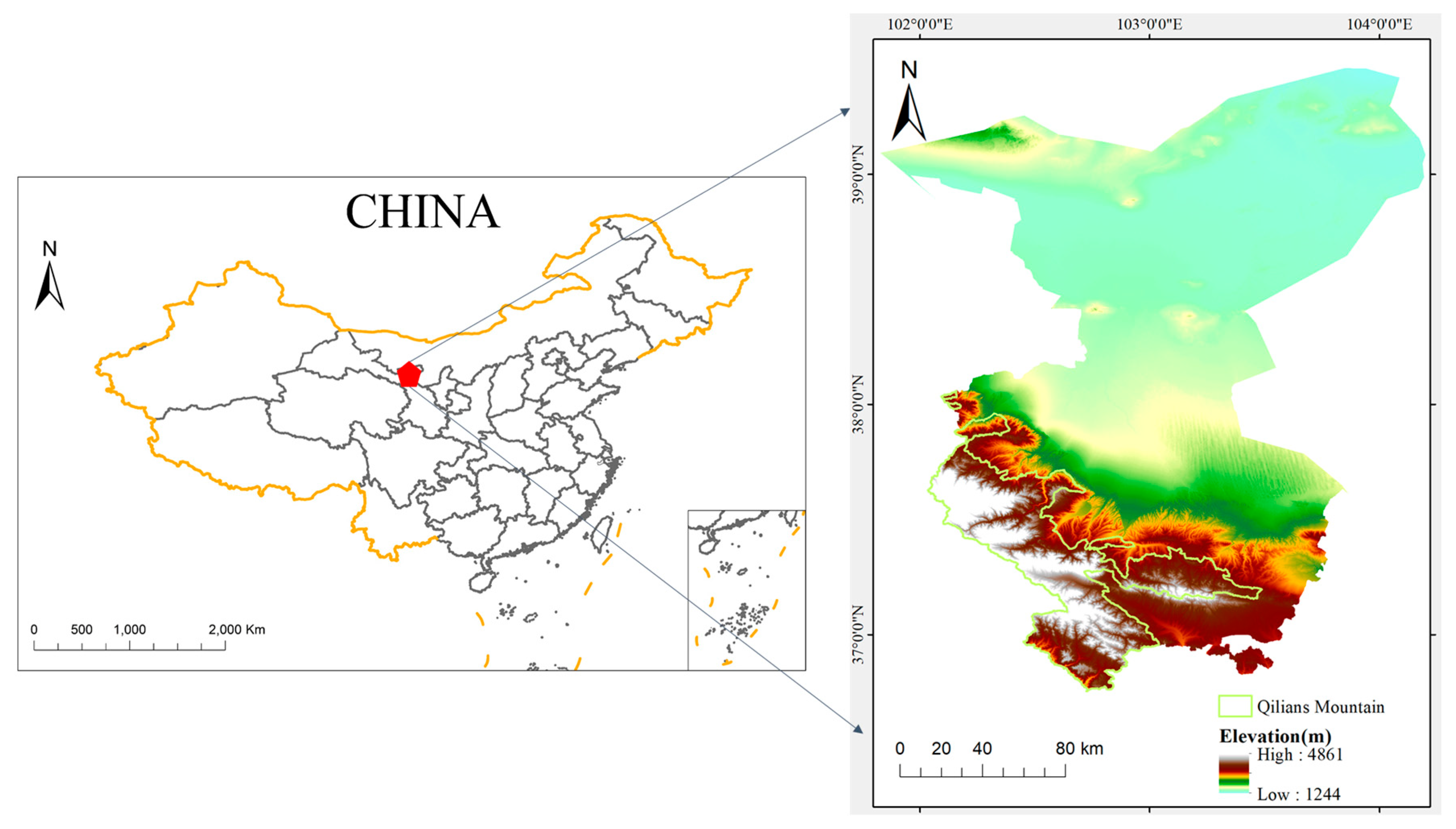
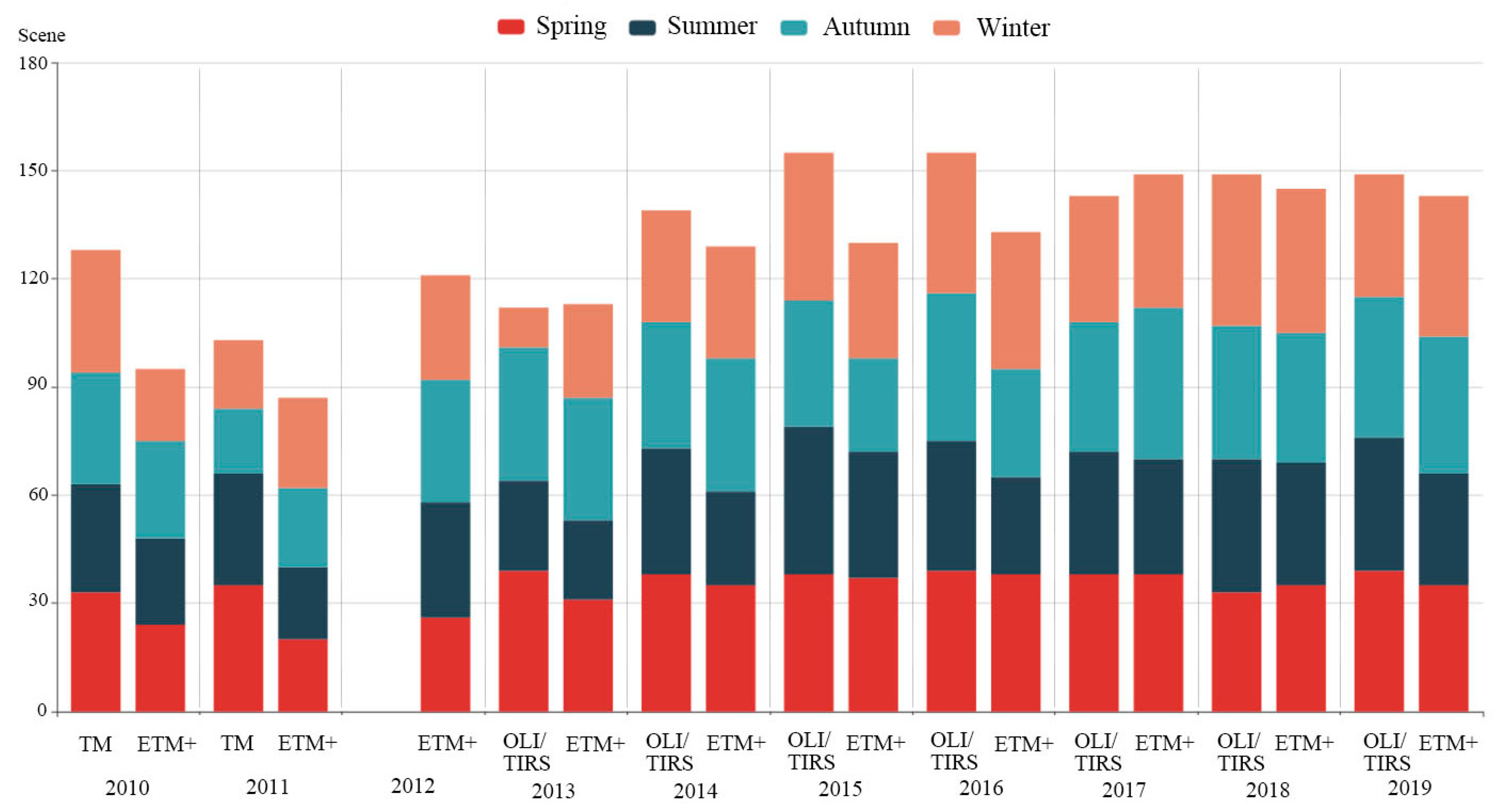

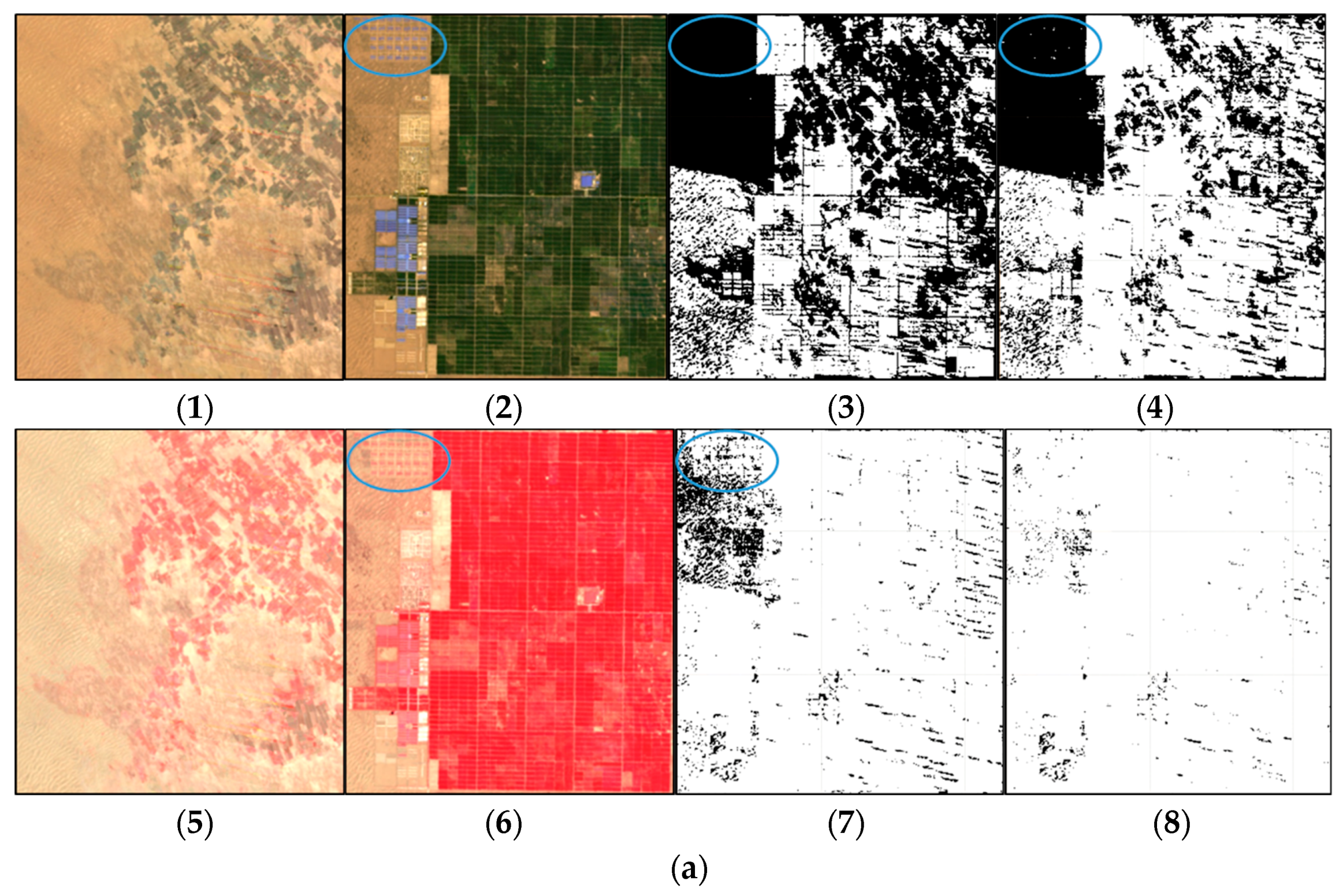

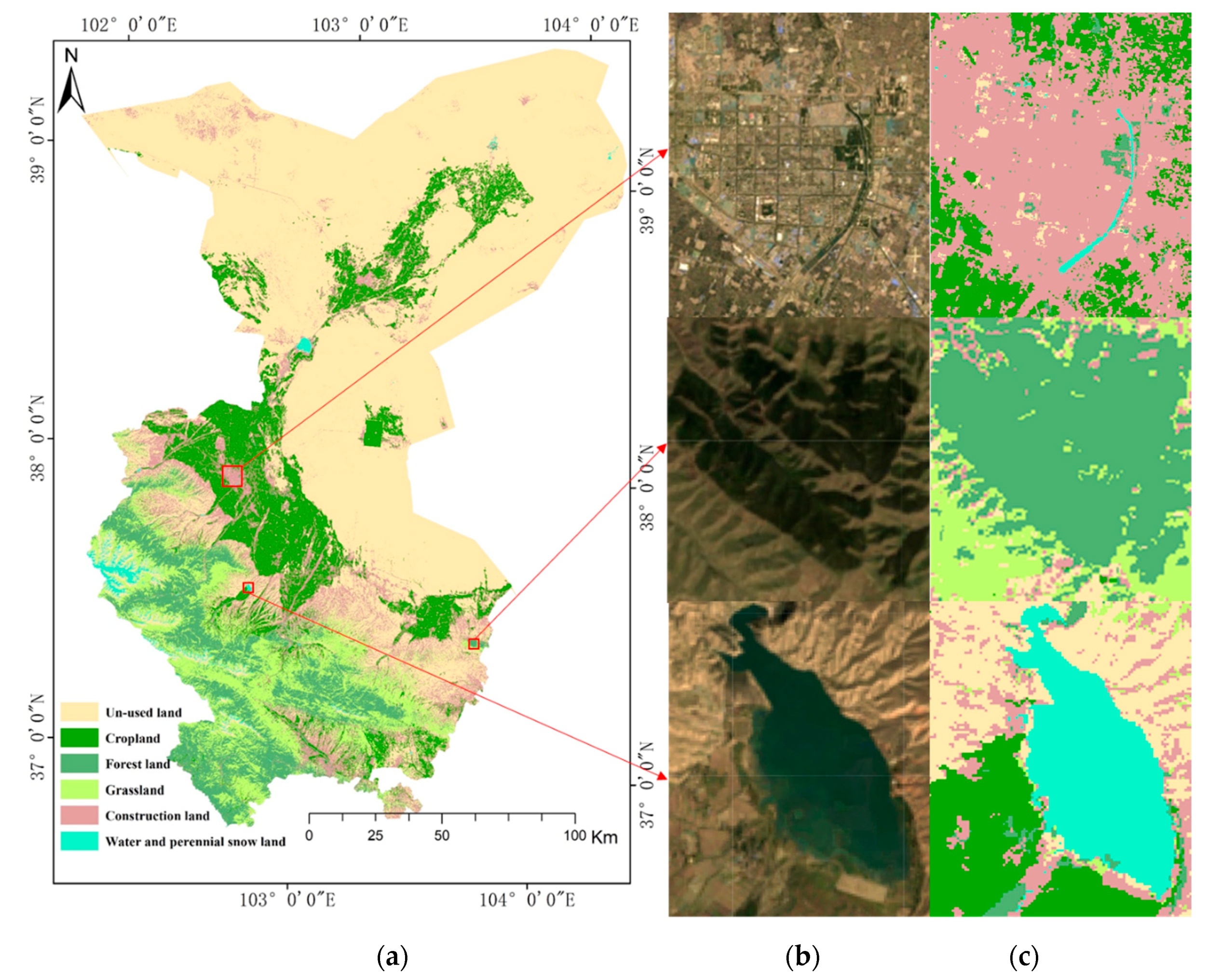
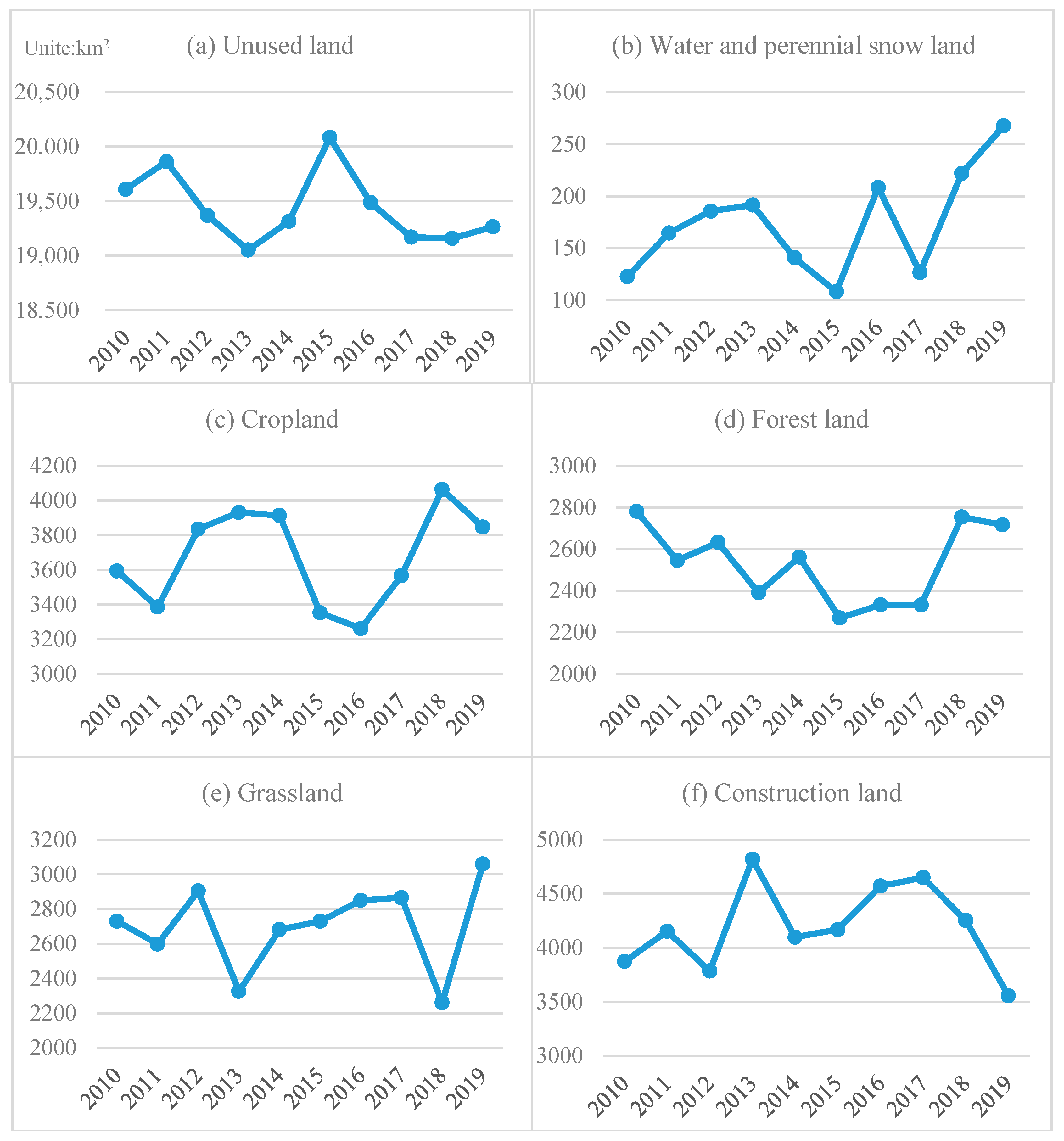



| Spectral Features | Season (*41) | B/G/R/NIR/SWIR1/SWIR2/NDVI/EVI/GNDVI/SAVI/NDBI/MNDWI 2 |
| Year | NDVImax/NDVImin/EVImax/EVImin/GNDVImax/GNDVImin/SAVImax/ SAVImin/NDBImax/NDBImin/MNDWImax/MNDWImin | |
| Textural Features | Season (*41) | ASM/CON/COR/VAR/IDM/SENT 3 |
| Topographical Features | Year | Elevation/Slope/Aspect/Hill shade |
| Name | Computing Method | Ecological Meaning |
|---|---|---|
| Landscape Fragmentation Index (Ci) | The higher the value, the higher the degree of fragmentation. | |
| Landscape Isolation Index (Ni) | The greater the value, the more complex the landscape distribution and the lower the ecological stability of the landscape. | |
| Landscape Dominance Index (DOi) | The higher the value, the greater the impact of patches on the formation and evolution of landscape pattern. | |
| Landscape Disturbance Index (Ei) | a, b and c are the weights of the corresponding landscape index, and the sum is 1. According to the existing research results and combined with the actual situation of the research area, the values are respectively 0.5, 0.3, and 0.2. | |
| ERI | ERI describes the size of ecological loss in the sample plot and converts the spatial pattern into ecological risk variable through sampling method. |
| Ground Truth | ||||||||
|---|---|---|---|---|---|---|---|---|
| Unused Land | Water and Perennial Land | Cropland | Forest Land | Grassland | Construction Land | Users Accuracy (%) | ||
| Mapping Class | Unused land | 443 | 0 | 0 | 0 | 0 | 31 | 93.46 |
| Water and perennial land | 0 | 496 | 0 | 0 | 0 | 0 | 100.00 | |
| Cropland | 0 | 0 | 493 | 0 | 0 | 10 | 98.01 | |
| Forest land | 0 | 3 | 0 | 455 | 33 | 0 | 92.67 | |
| Grassland | 37 | 0 | 6 | 45 | 467 | 3 | 83.69 | |
| Construction land | 20 | 1 | 1 | 0 | 0 | 456 | 95.40 | |
| Producer Accuracy (%) | 88.60 | 99.20 | 98.60 | 91.00 | 93.40 | 91.20 | ||
| Overall Accuracy (%) | 93.67 | Kappa | 0.92 | |||||
| Years | Overall Accuracy (%) | Kappa Coefficient |
|---|---|---|
| 2010 | 93.83% | 0.93 |
| 2011 | 90.27% | 0.88 |
| 2012 | 91.63% | 0.90 |
| 2013 | 91.10% | 0.89 |
| 2014 | 92.40% | 0.91 |
| 2015 | 92.30% | 0.91 |
| 2016 | 92.33% | 0.91 |
| 2017 | 91.40% | 0.90 |
| 2018 | 93.83% | 0.93 |
| 2019 | 93.67% | 0.92 |
| Ground Truth | ||||||||||
|---|---|---|---|---|---|---|---|---|---|---|
| 2010–2019 | 2013–2019 | 2016–2019 | ||||||||
| Mapped | Change | Non-Change | User Accuracy | Change | Non-Change | User Accuracy | Change | Non-Change | User Accuracy | |
| Change | 7341 | 694 | 91.36% | 9111 | 455 | 95.24% | 5740 | 479 | 92.30% | |
| Non-Change | 1225 | 8027 | 86.76% | 866 | 9023 | 91.24% | 564 | 10434 | 94.87% | |
| Producer Accuracy | 85.70% | 92.04% | 91.32% | 95.20% | 91.05% | 95.61% | ||||
| Overall Accuracy | 88.90% | 93.21% | 93.94% | |||||||
| 2019 | ||||||||
|---|---|---|---|---|---|---|---|---|
| Unused Land | Water and Perennial Land | Cropland | Forest Land | Grassland | Construction Land | Total | ||
| 2010 | Unused land | 18,992.60 | 45.26 | 191.70 | 26.20 | 182.96 | 170.91 | 19,609.45 |
| Water and perennial land | 2.69 | 117.90 | 0.03 | 0.19 | 1.73 | 0.14 | 122.68 | |
| Cropland | 78.80 | 11.62 | 3238.99 | 25.82 | 159.18 | 79.21 | 3593.62 | |
| Forest land | 22.43 | 46.13 | 2.97 | 2409.55 | 297.43 | 2.55 | 2781.06 | |
| Grassland | 65.99 | 44.20 | 17.41 | 229.26 | 2360.53 | 13.46 | 2730.85 | |
| Construction land | 102.47 | 2.56 | 395.74 | 25.27 | 58.13 | 3288.92 | 3873.10 | |
| Total | 19,264.99 | 267.67 | 3846.84 | 2716.10 | 3059.95 | 3555.20 | 32,710.75 | |
Publisher’s Note: MDPI stays neutral with regard to jurisdictional claims in published maps and institutional affiliations. |
© 2021 by the authors. Licensee MDPI, Basel, Switzerland. This article is an open access article distributed under the terms and conditions of the Creative Commons Attribution (CC BY) license (https://creativecommons.org/licenses/by/4.0/).
Share and Cite
Zhang, T.; Du, Z.; Yang, J.; Yao, X.; Ou, C.; Niu, B.; Yan, S. Land Cover Mapping and Ecological Risk Assessment in the Context of Recent Ecological Migration. Remote Sens. 2021, 13, 1381. https://doi.org/10.3390/rs13071381
Zhang T, Du Z, Yang J, Yao X, Ou C, Niu B, Yan S. Land Cover Mapping and Ecological Risk Assessment in the Context of Recent Ecological Migration. Remote Sensing. 2021; 13(7):1381. https://doi.org/10.3390/rs13071381
Chicago/Turabian StyleZhang, Tingting, Zhenrong Du, Jianyu Yang, Xiaochuang Yao, Cong Ou, Bowen Niu, and Shuai Yan. 2021. "Land Cover Mapping and Ecological Risk Assessment in the Context of Recent Ecological Migration" Remote Sensing 13, no. 7: 1381. https://doi.org/10.3390/rs13071381
APA StyleZhang, T., Du, Z., Yang, J., Yao, X., Ou, C., Niu, B., & Yan, S. (2021). Land Cover Mapping and Ecological Risk Assessment in the Context of Recent Ecological Migration. Remote Sensing, 13(7), 1381. https://doi.org/10.3390/rs13071381









